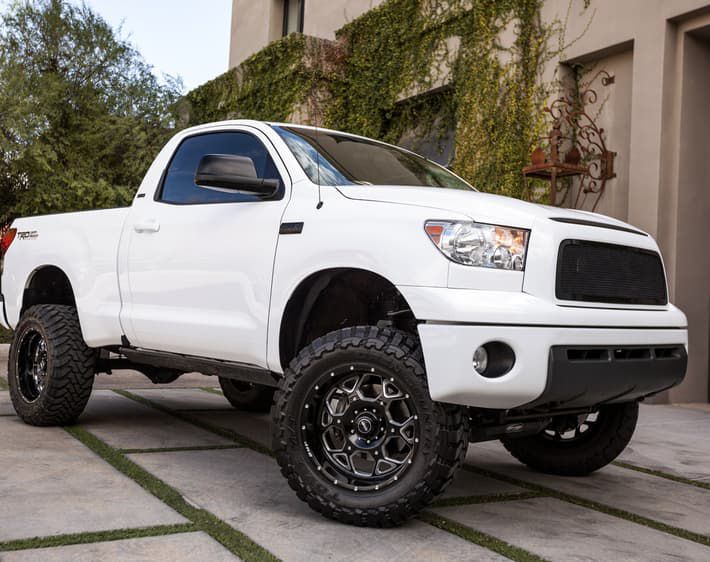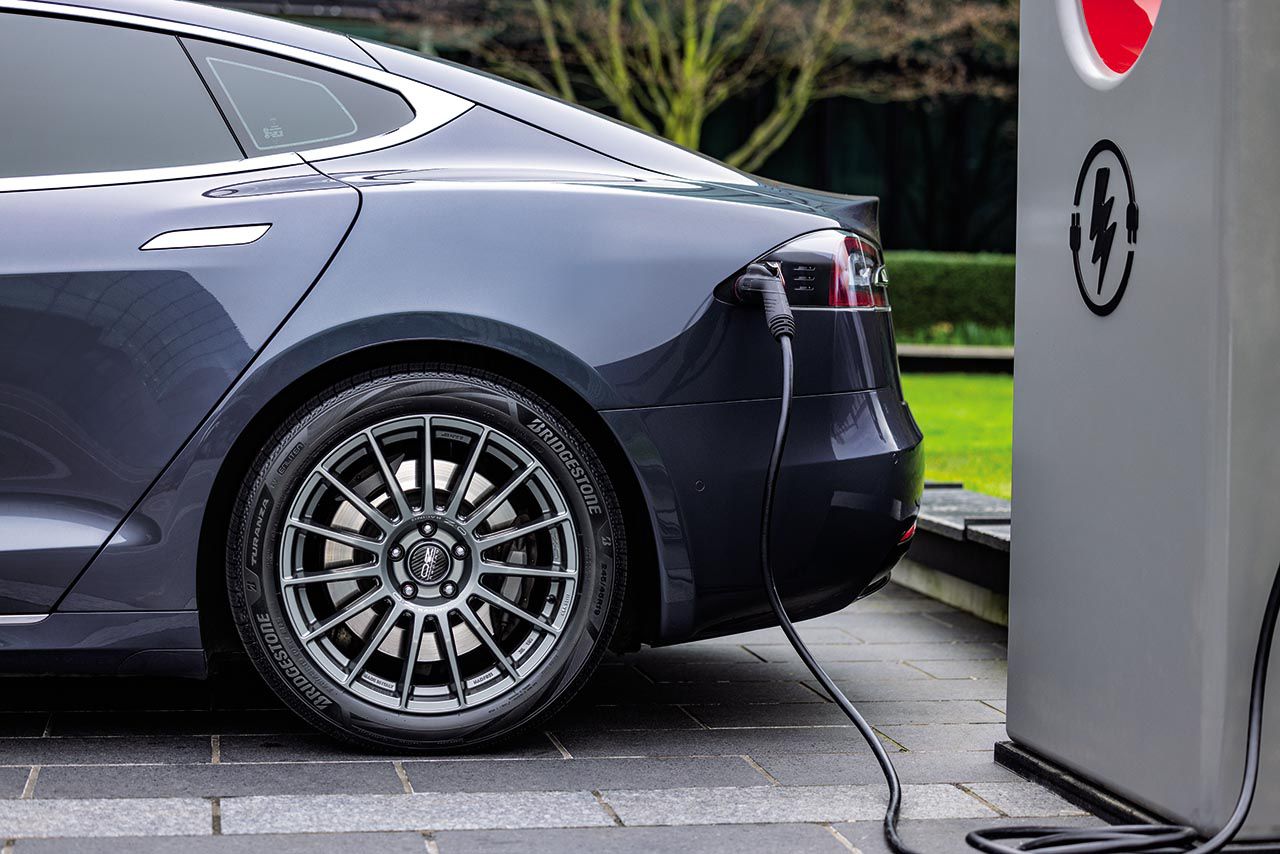If you’re picking out your perfect set of tires and are wondering, “Can I use bigger tires on my car?” The answer is, "it depends!" Before deciding if putting bigger tires on your car is a good idea, there are a few key considerations to remember. We’ll break down some of the pros and cons, plus what happens when you put bigger tires on your car–including potential impacts on fuel economy, handling, and even speedometer accuracy.
| Overview: Pros and Cons of Bigger Tires on Trucks and Cars | |
|---|---|
| Pros | Cons |
| Increased ground clearance | Reduced fuel efficiency |
| Improved off-road performance | Altered handling and stability |
| Enhanced style | Additional costs for modifications & adjustments |
| Potential warranty void | |
Benefits of Bigger Tires
First thing first, let’s talk the benefits of upgrading (or upsizing, rather) your tires! From gaining more ground clearance to creating a tougher appearance, these are the benefits of bigger tires.
Increased Ground Clearance
One of the most notable advantages of larger tires is the extra height they provide. For off-roading enthusiasts, this additional clearance helps vehicles clear rough terrain and obstacles more easily. Higher clearance can also improve visibility on the road, allowing you to see further ahead.
Enhanced Off-Road Performance
With their broader tread and greater contact area, larger tires can provide better traction on uneven and loose surfaces. This is especially beneficial for all-terrain or max-traction tires that tackle dirt, mud, and gravel. If off-roading is your goal, bigger tires may help your truck or SUV handle more adventurous trails.
Custom Styling and Curb Appeal
Bigger tires paired with custom wheels create a distinct look, enhancing your vehicle's aesthetic appeal. For those interested in style, this can make a bold statement and give your truck or SUV that rugged, eye-catching appearance you're shooting for.
Cons of Bigger Tires
Yes, putting bigger tires on a car can have benefits. But, there are some potential drawbacks to think about, too. From spending more at the pump to shelling out cash for additional modifications, here are some of the downsides of putting larger tires on your ride.
Reduced Fuel Efficiency
Compared to smaller tires with less road resistance–which can help you save money–bigger tires can cost you more money at the pump. Bigger tires typically add weight, which increases your rolling resistance on the road. This means your engine has to work harder, which can lower your fuel efficiency.
Aggressive tread patterns that are commonly featured on larger tires may also create more friction, leading to higher fuel consumption, especially when city driving or driving at higher speeds on highways.
Altered Handling and Stability
Raising the vehicle’s height with bigger tires shifts its center of gravity which can alter the vehicle’s handling. This may increase the risk of body roll and load transfer during turns.
Opting for larger tires can also impact handling, particularly sudden braking or cornering at higher speeds, which can make your vehicle feel less stable than before. Changes in ride height and alignment angles may affect the ability to recalibrate your Advanced Driver Assistance Systems (ADAS). To be extra safe, you should thoroughly read any warnings provided by your vehicle manufacturer and installer.
Additional Costs for Modifications and Adjustments
Installing bigger tires is rarely as straightforward as simply swapping them out–and typically requires both parts and work. In some cases, larger tires require a lift or leveling kit to fit properly, which can affect future alignment needs and involve added costs.
Opting for bigger tires can also mean you need new rims and, for certain vehicles, adjustments to the speedometer or tire pressure monitoring system (TPMS).
Your auto insurance rates may also be impacted by installing bigger tires or a lift kit. Be sure to check with your insurance agent before altering your vehicle.
Potential Warranty Impact
Auto manufacturers typically suggest a recommended tire size. Some manufacturers will advise against changing tire sizes due to the strain they can place on the powertrain and suspension.
In some cases, using non-standard tire sizes or lift kits may void the vehicle’s warranty, particularly if these modifications result in mechanical issues. If you’re considering a tire swap, be sure to refer to your vehicle’s manufacturer warranty first.
Bigger Tires vs. Bigger Wheels: What’s the Difference?
Swapping out your tires isn’t the only option available! When modifying your tire setup, there are generally two main approaches: plus-sizing and up-sizing.
What is Tire Plus-Sizing?
Tire plus-sizing involves installing wheels with a larger diameter but using lower-profile tires that keep the total tire diameter similar to the original. Plus-sizing generally does not affect ground clearance or the speedometer, and in some cases, plus-sizing can enhance cornering and handling.
However, this setup is often chosen primarily for stylistic reasons. Our experts at your local Tires Plus can help determine if plus-sizing is right for your vehicle.
What is Tire Up-Sizing?
Tire up-sizing involves choosing tires with a larger diameter than the manufacturer’s recommendations, which can impact various aspects of the vehicle, including speedometer accuracy and fuel economy.
Upsizing typically involves changing both the tire and wheel size and may require recalibrating the speedometer or updating your vehicle’s electronic systems. Keep in mind that larger tires can also create additional strain on components like brakes and suspension if they’re not designed for the extra weight.
Trust Tires Plus for Your Tire Upgrade
Thinking about upgrading to bigger tires? Visit your nearest Tires Plus location, where our experts can guide you through plus-sizing, up-sizing, and all your tire selection needs. We’ll help you find the right tires for your make and model to ensure the driving experience you’re looking for — whether that’s added style, off-road capability, or a balance of both. Schedule your appointment now!
Fast FAQs About Bigger Tires
Do Bigger Tires Affect MPG?
Yes, bigger tires generally reduce MPG due to added weight and increased rolling resistance.
Do Bigger Tires Affect Speedometer Readings?
Yes, larger tires impact speed readings, so it’s best to have a professional adjust the speedometer for accuracy.
Is Plus-Sizing the Same as Up-Sizing?
No. Plus-sizing involves larger wheels with low-profile tires, keeping the diameter close to the original specs. Up-sizing refers to tires with a larger diameter, affecting clearance and other factors.


